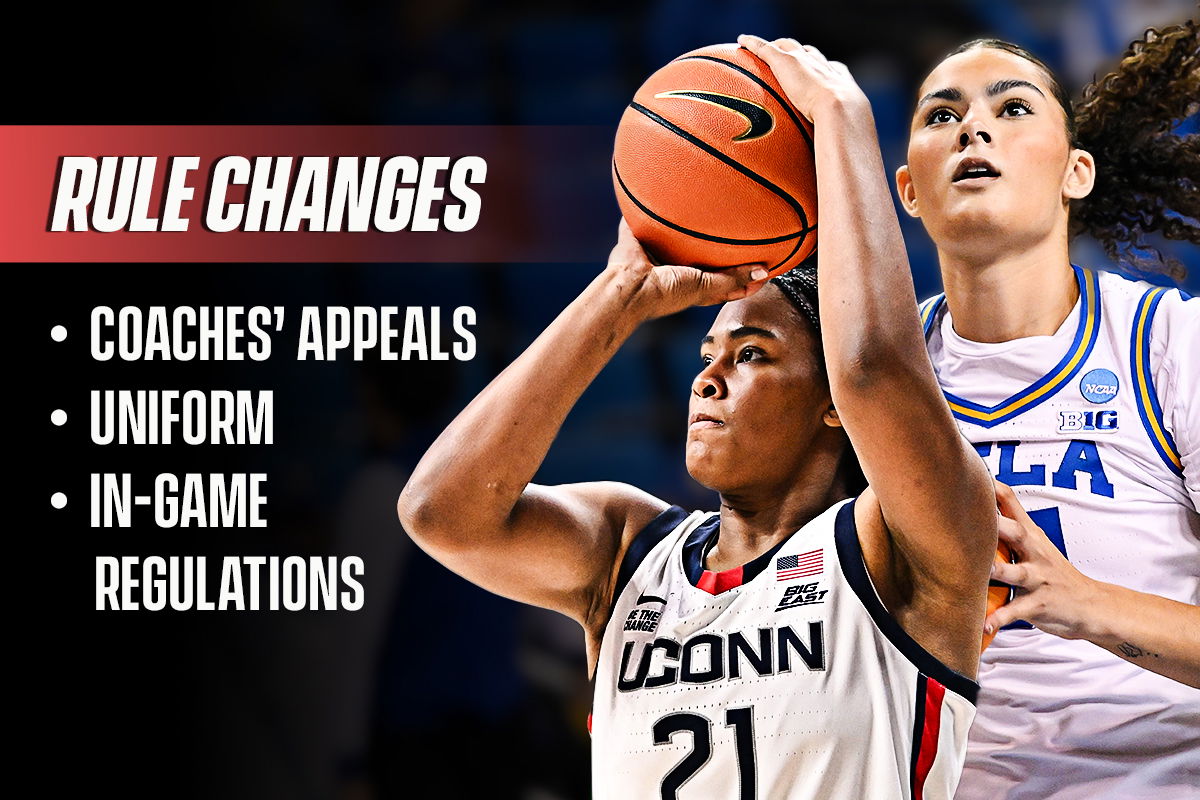
Imago
Credits: Imago

Imago
Credits: Imago
Women’s basketball has come a mighty long way since its humble beginnings in 1892, and today, it’s moving forward by leaps and bounds. But while the NCAA has rolled out more than 50+ rule changes since its inaugural season, a few major ones (especially those involving coaches) were still hanging in limbo.
Watch What’s Trending Now!
Year after year. After a while, it got a little annoying. Maybe even downright frustrating. Or, as some coaches said, “Irritating!” Those adjectives sound a bit too dramatic, but trust me, they fit the mood. Anyway, better late than never, I guess? Because the NCAA WBB 2025–26 Rulebook just got a shiny, much-needed upgrade. And since college hoops are officially back, you might need a quick update.
ADVERTISEMENT
What’s new in 2025-26
After a thorough discussion back in September, the NCAA Women’s Basketball Rules Committee finally voted to recommend some big changes for the 2025-26 season. But before we break them down, here’s a quick rundown:
- Coaches’ Challenges
- Game Flow & Court Boundaries
- In-Game Regulations: Traveling, Fouls, and More
- Uniform Updates
ADVERTISEMENT
Coaches’ Challenges
The topic of coaches’ challenges has been floating around forever. It was first deployed as an experiment during the WBIT. And now, under the new rule changes, coaches in women’s basketball will officially be able to challenge specific plays during a game, and here’s what they can now contest:
Top Stories
Greg Biffle Plane Tragedy: What Might Have Caused the Crash That Killed the NASCAR Champ and His Family

What Is Alycia Baumgardner’s Net Worth in 2025? Career Earnings, MVP Deal With Jake Paul, Biggest Purse & More

Jake Paul vs. Anthony Joshua Fight Purse: How Much Are Alycia Baumgardner and Others Earning?

Leila Beaudoin Relationship Status: Is the Canadian Boxer Married or Single?

Alycia Baumgardner Boyfriend/Husband: All About Her Relationship Status and Dating History

Jahmal Harvey vs. Kevin Cervantes Stats Comparison and Prediction: Record, Age, Height, Reach, Weight, Knockout Ratio, and Rankings

- Out-of-bounds rulings
- Backcourt violations
- Whether the right player was called for a foul
- Whether a change in possession happened before a foul that led to free throws
ADVERTISEMENT
There’s a small twist, though. Officials can’t start reviews on these plays themselves, except in cases where they need to confirm if the foul was called on the correct player.
And while the men’s side still requires teams to have a timeout in hand to challenge a play, the women’s game is doing things a little differently. Coaches won’t need a timeout to make a challenge. However, if it’s unsuccessful, it’ll count as a technical foul for an “excessive timeout.”
Another key update gives officials a bit more flexibility when it comes to fouls. They can now call a Flagrant 1 for contact to the groin area. Previously, that could only be ruled as either a common foul or a Flagrant 2, which meant immediate ejection.
ADVERTISEMENT

Imago
NCAA, College League, USA Womens Basketball: Louisiana State at Texas Feb 16, 2025 Austin, Texas, USA Louisiana State Lady Tigers head coach Kim Mulkey watches the first half against the Texas Longhorns at Moody Center. Austin Moody Center Texas USA, EDITORIAL USE ONLY PUBLICATIONxINxGERxSUIxAUTxONLY Copyright: xScottxWachterx 20250216_neb_wa5_120
Note: For exhibition games only, there was an experimental rule. Coaches were allowed (if both teams agree) to appeal any foul called against their team at any point in the game. There was no limit on the number of appeals, but they must be made before play resumes. If an appeal fails, it would have cost the team a timeout.
ADVERTISEMENT
Game flow & court boundaries
What are the changes about? Simply put, these will help the game move a little faster and cleaner.
First up, the shot clock.
From now on, when the offense gets the ball in its frontcourt after a dead ball, the shot clock will reset to 20 seconds instead of 30. Why? Because teams don’t need those extra 10 seconds since they’re already near the basket. This small change should speed up play and give us a few more possessions per game.
ADVERTISEMENT
Then there’s out of bounds.
Basically, bench help is officially off-limits. If someone on the bench physically helps a player stay inbounds or pushes them to move a certain way, it’ll be penalized. Of course, accidental contact won’t count, but anything intentional will.
ADVERTISEMENT
In-game regulations: Traveling, suspensions, fouls, and more
See, the intent here is to break them down for you in the simplest way possible. So, let’s do one rule at a time.
Jump stop gets the green light
Players can now legally do a jump stop or step back, even if their feet don’t land exactly at the same time, as long as it’s close enough. The NCAA realized the game’s gotten faster, and refs were struggling to call travels accurately when players made quick moves. So now, landing “approximately” together is good to go.
ADVERTISEMENT
No more unnecessary travel whistles on those quick stops.
Why the change? The current traveling rule requires both feet to land simultaneously. So, this proposal would increase accuracy on traveling rulings due to the increased speed of the players when determining whether the feet land simultaneously.
The “hot stove” rule for defenders
Defenders can now touch the ball handler with more than one quick “hot stove” touch (you know, those brief taps like you’d do on a hot stove – in and out).

Imago
December 7, 2024, Brooklyn, New York, USA: UConn Huskies forward SARAH STRONG 21 drives to the basket past Louisville Cardinals forward ISLA JUFFERMANS 15 during the first half. Brooklyn USA – ZUMAb273 20241207_zsp_b273_035 Copyright: xJordanxBankx
It’s fine as long as it’s not persistent or doesn’t mess with the dribbler’s rhythm, speed, or direction. Basically, if it doesn’t actually slow them down or reroute them, play on.
New take on technicals
If a team accidentally has six players on the court or calls an extra timeout, they don’t have – that’s now a team technical foul. So instead of being labeled as an “administrative” mistake, it officially counts toward the team’s total. After the free throws, the opposing team will also get the ball at half-court.
These offenses are committed by players and coaches (teams) and are not administrative, so placing them under the Team Technical Foul category is an appropriate placement, as the players and coaches commit these technical fouls.
Suspensions got stricter
If a player is supposed to sit out a game for fighting or for physically abusing an official but doesn’t, that’s an automatic one-game suspension. Plus, the head coach also gets suspended for a game if the player skips their suspension.
Uniform & apparel updates
This one’s all about keeping things practical to fit modern standards.
– First up, jerseys no longer need to be tucked in. The NCAA realized that today’s jerseys are made shorter, and trying to keep them tucked while playing intense basketball is a losing battle. So, no more constant tucking breaks mid-game. Why was it needed? When players lift their arms, the jersey often becomes untucked, making it difficult for officials to enforce the rule properly.
– Next, headbands. The old limit was 2 inches wide, but now players can rock headbands up to 4 inches. A small change, sure, but it means more comfort.
– And lastly, tights and leg sleeves now have to match in color. The rule used to be a bit confusing, especially with different sleeve lengths and styles. Now, the NCAA just wants everything below the waist in one consistent shade.
All in all, it’s pretty clear what the NCAA was going for: smoother play, fewer interruptions, and a rulebook that actually fits the game today.
And as we step into a new season, there’s a sense that things might never quite look the same again. With tournament expansion talks, this could be the final run under the current setup. But if change is coming, at least the game’s evolving in the right direction with young stars taking the court.
ADVERTISEMENT
ADVERTISEMENT
ADVERTISEMENT

